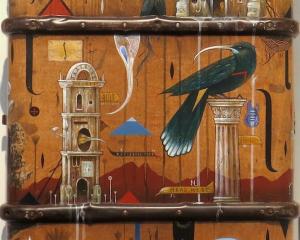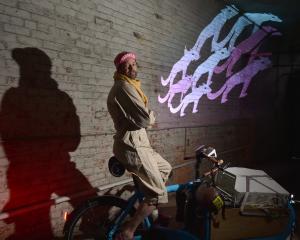
The year is 1988.
Art historian and lecturer Peter Stupples has joined the Dunedin Public Art Gallery Society’s council, keen to develop a relationship between the University of Otago’s new art history course and the Dunedin Public Art Gallery.

Little did he know he was about to experience some of the most controversial times in the society’s long history.
"It was turbulent times."
Stupples, who was involved in the society for around 20 years from 1988 to 2002, including a two-year stint as president, has been reflecting on the society’s history in preparation for the 100th annual meeting, remembering those days with some chagrin.
"It was a pretty fatal year in some ways. It had its major crisis. The Peter Entwisle crisis as I called it."
Back then the society’s council still ran the art gallery and employed its staff but it was negotiating with the Dunedin City Council to take over the collection.
The curator was the late Peter Entwisle, who it was alleged was behind a letter offering to sell the society’s collection to the National War Memorial Museum and Art Gallery for a nominal sum over a disagreement with how the society was handling the negotiations.
It led to the society’s council sacking him and urging the director of the gallery, the signatory of the letter, to retire. Accounts from the Otago Daily Times at the time show Entwisle was reinstated but the "furore", which made the front pages of the newspaper, continued for months, amid calls for the society’s vice-president to stand down for his role in it.
"This split the whole city involved with the arts."

It began when William Mathew Hodgkins (1833-98), who had a love of art, tried to set up a public art gallery beginning with the Society of Artists in 1875, which became the Otago Art Society a year later. The society then approved Hodgkins’ plan to begin a "public collection of pictures in Dunedin".
Their "lofty" goal was to was to build from nothing a collection of pictures representing significant moments in European art history as well as locally painted New Zealand contemporary "masterpieces".
While it started off in the Maritime Hall of the Otago Museum, it soon shifted to its second home in the Municipal Chambers — by that time its collection comprised seven oil paintings, six watercolours and some old master reproductions.
A group of Dunedin citizens raised funds to buy works by inviting people to subscribe or contribute money and as such became members of what became known as the Dunedin Public Art Society.
"It was the Royal Terrace group of people, the Jewish traders and Scottish settlers coming together to fund an art gallery."
About then, the gallery was moved into two corrugated iron sheds placed at the end of the Otago Museum, so fundraising, led by the society, began to get a more suitable purpose-built space — what is now Toitu Otago Settlers Museum.

Robyn Notman, then public programmes manager at the DPAG, in the book Beloved, Works from the Dunedin Public Art Gallery (2009) described this period as a "sparkling era" for the gallery.
"Through the generosity of benefactors, reliable and expanded acquisitions funding was available for the first time in its history and this combined with good taste and good judgement heralded a period of important collection development."
The society’s trustees then got together with the Otago Art Society, a grouping of local artists, in 1922 with an elected council now jointly owning and running the gallery.
In 1924, the society made the major decision to give the gallery to the Dunedin City Council, which in turn would provide funds for its running costs, while the society would continue to administer it and buy works for the collection using its own funds.
At the same time, the gallery moved into the building at Logan Park built for the South Seas Exhibition and donated by the Sargoods in memory of their son killed at Gallipoli.
A few years later, the OAS decided to split from the society, leaving the gallery in the sole control of the society and the city.
"It was the DPAGS, the funders, who managed the collection and gallery over that long period of time, employing staff , acquiring works, getting donations," Stupples says.
The society was also responsible for employing New Zealand’s first female art gallery director in former artist-turned-farmer’s wife Annette Pearse in 1945. Interestingly, she got the job over artist Colin McCahon, who was also short-listed.
While the DCC took over running of the gallery in 1989, the society kept its funding and its acquisitions committee, of which Stupples was a member for many years.

The appointment of another female director, Dame Cheryll Sotheran, in 1990 was also life-changing for the gallery, Stupples says. She was the first New Zealand director of the gallery.
"Both Cheryll Sotheran and Priscilla Pitts, who took over in 1998, were very forward-looking directors."
Having come from outside Dunedin, the women were able to see that the gallery was very inward looking.
"It had no outside perspective. These two women coming in made a huge difference to the gallery."
The directors before that had been extremely conservative, looking towards British art and later New Zealand art derived from British art, as did most galleries of the time.
"The gallery society was also very conservative and while Charles Brasch [poet] was on the council he was a lone voice. In the end he left the council because of the failure of the council’s acquisitions committee to look toward the more avant garde artists here in Dunedin. It took some years for the gallery to resight its initiatives toward modern New Zealand art."
By the 1980s there began to be a big shift towards more modern New Zealand art in galleries across the country.
Prior to Sotheran’s appointment the acquisitions committee was a "power in itself".
"It was only when she was appointed there was a contestation, a friendly one, between the council having the purse strings and the gallery knowing what it wanted in its collection and saying ‘we are the professionals and you are all amateurs’."
Eventually the council decided to let the gallery have its way, he says.
"That happened while I was involved. The acquisitions committee first ran the show then eventually the art gallery itself ran the show. It was very amicable."
In the late 1980s it was also decided the Logan Park building was unsuitable and the search began for a new gallery site.
When the DIC department store closed, it was decided to relocate the gallery to the Octagon. It took seven years before it relocated in 1997.
"The move to the DIC building was hugely successful."
Over the years the society council did various fundraising projects to mark milestones with special acquisitions, including a commemorative collection to mark the 150th anniversary of the establishment of the region of Otago which included works by Otago artists such as Grahame Sydney, Colin McCahon and Ralph Hotere and a ballet, Leaf, by Daniel Belton with music by Anthony Ritchie.
Stupples remembers meeting Hotere for lunch to ask him to do a work for the collection. Hotere agreed but when nothing was forthcoming, Stupples questioned him.
"He told me he’d decided not to do one but he had another one he’d already made. So we said OK. You didn’t argue with Ralph Hotere."

"It has a wonderful collection due to all of these quite accidental factors."
Today’s society chairman Ross Currie says its remit has not changed in its 100 year history although it is becoming more modernised.
"We are still providing funds for major purchases every year."
Recent acquisitions have included works by Imogen Taylor, Hotere and Fiona Pardington.
"When I first saw the Pardington pieces go up I was gobsmacked. And the Hotere pieces are pivotal to the collection as they fill a significant gap from his early years."
Its main focus is on retaining membership and on increasing Dunedinites’ knowledge and awareness of the visual arts in the city and the role of the society.
"We like to highlight emerging artists and support them as well."
Dunedin Public Art Gallery Society timeline
1875: The Society of Artists is formed, then becomes the Otago Arts Society in 1876.
1882: OAS began collecting paintings.
1884: The Dunedin Public Art Gallery is established — New Zealand’s first art gallery — in the Maritime Hall at Otago Museum.
1888-90: The collection is based in the Municipal Chambers, in the Octagon.
1890: The Dunedin Public Art Gallery Society is formed.
1907: The collection is moved to a purpose-built building now housing Toitu Otago Settlers Museum.
1922: The DPAG Society and Otago Art Society merge to form DPAGS.
1924: The gallery and collection is given to the DCC in return for regular funding.
1927: Gallery moves to a building at Logan Park after the South Seas Exhibition.
1930: OAS separates to focus on local artists while DPAGS continues to run the gallery.
1989: Management of gallery is taken over by the DCC.
1996: Gallery is relocated to Octagon building it is in today.
DPAGS continues to fund new works for the DPAG.












![... we all become all of these things [installation view] (2025), by Megan Brady.](https://www.odt.co.nz/sites/default/files/styles/odt_landscape_small_related_stories/public/story/2025/03/1_we_all_become_all_of_thes.jpg?itok=nicA_yAm)